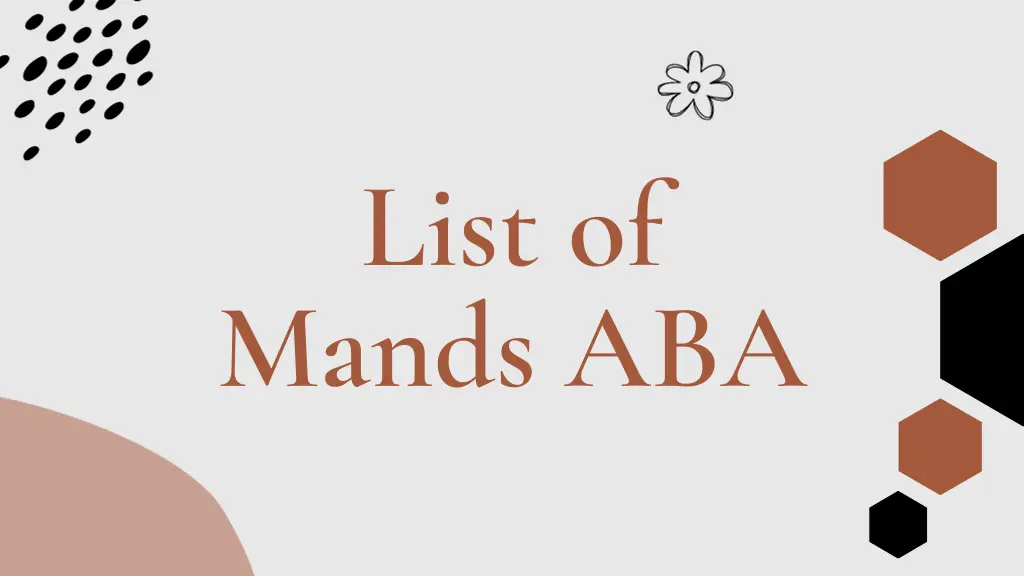Communication is one of the most essential life skills, yet many children and individuals with developmental or speech delays struggle to make their needs known. This challenge often leads to frustration, misunderstandings, and even behavioral issues. Applied Behavior Analysis (ABA) therapy provides an evidence-based framework to help learners overcome these barriers, and one of its most powerful strategies is the use of mands.
The list of mands ABA is a practical tool that organizes the most common requests children may need in their daily lives. By learning these mands, learners gain the ability to ask for items, activities, attention, help, and even information, rather than relying on frustration or disruptive behavior. This article will provide a detailed overview of the list of mands in ABA, explain how each one is used, and highlight the benefits of incorporating them into therapy and everyday routines.
What are Mands in ABA Therapy?
Mands are one of the first forms of functional communication taught in ABA therapy. When a toddler cries for milk, points to a toy, or pulls a parent’s hand toward something they want, those are natural examples of manding. ABA therapy builds on these instincts and shapes them into more structured, socially appropriate forms of communication.
A mand essentially gives the learner power over their environment. Instead of feeling helpless when they want something, they can request it directly. This reduces problem behaviors such as tantrums or aggression, which often arise when children cannot communicate effectively. For therapists and parents, teaching mands provides a bridge between a child’s internal needs and the external world.
Why the List of Mands ABA is Important
The mands ABA is not just a collection of vocabulary words it is a functional set of communication tools. Each mand targets a specific kind of interaction that learners are likely to need in their daily lives. Teaching these systematically ensures that communication is both practical and relevant.
For example, a child who can ask for food or toys feels more independent at home. A learner who can request help avoids frustration at school. Someone who knows how to ask for a break can manage their emotions better in challenging situations. In each case, mands provide a healthier alternative to negative behaviors.
By working through the complete list of mands, ABA therapists help learners build a strong communication foundation. This foundation not only supports language development but also enhances social skills, reduces stress for families, and empowers learners to take more control of their experiences.
The Complete List of Mands in ABA Therapy
Here is an expanded explanation of the most important mands taught in ABA therapy. Each mand plays a unique role, and together they provide learners with the tools to engage meaningfully with others.
Essential Mands in ABA
Mand for Items or Objects
The mand for items is often the first communication skill taught in ABA because it is highly motivating for learners. It involves requesting tangible things like food, toys, books, or clothing. For example, a child may say “cookie” when they want to eat one. Teaching this mand helps learners understand that their words or gestures can directly lead to getting something they desire. Over time, this reduces reliance on pointing or crying and encourages the development of more complex language.
Mand for Activities
Beyond objects, many learners enjoy specific activities such as swinging, drawing, or playing outside. The mand for activities teaches them to request experiences rather than things. For example, a learner may say “swing” when they want to play at the playground. This mand is powerful because it connects communication to joyful moments, reinforcing that language leads to positive outcomes. It also broadens the learner’s ability to participate in group or family activities by making their preferences known.
Mand for Attention
Attention is a universal human need, and children often engage in disruptive behaviors when they don’t know how to request it properly. The mand for attention gives them a positive way to get interaction. A learner may say “play with me” or “look at me” instead of yelling or acting out. This not only strengthens social bonds but also builds self-confidence by teaching them that communication, rather than misbehavior, is the best way to connect with others.
Mand for Help
Frustration often arises when learners cannot complete a task independently. The mand for help equips them with the ability to seek assistance appropriately. For example, if a puzzle piece doesn’t fit, a learner can say “help” instead of crying. This mand teaches problem-solving and collaboration while reducing stress for both the learner and caregiver. It also fosters resilience, since the child learns that challenges can be managed with communication.
Mand for a Break
Some learners become overwhelmed during structured activities or therapy sessions. The mand for a break allows them to request time away in a healthy manner. Instead of escaping by running off or refusing tasks, they can say “break” to pause. This builds self-regulation skills and gives them a sense of control over their environment. For therapists, it also provides insight into when a child may be reaching their limits, allowing for more effective support.
Mand to Stop or Escape
There are times when learners need to end an unpleasant or uncomfortable situation. The mand to stop or escape teaches them to ask for change respectfully. A child may say “stop” during a noisy activity or “all done” when they don’t want more food. This type of mand reduces negative behaviors like screaming or aggression because the learner gains a socially acceptable alternative for expressing their needs.
Mand for Information
As children develop curiosity, they naturally begin asking questions like “where,” “what,” or “why.” The mand for information supports this stage by teaching learners to seek knowledge through communication. For example, a learner might say “where’s mom?” or “what’s that?” This mand expands beyond basic needs and lays the groundwork for conversations, critical thinking, and academic learning.
Mand for People
Sometimes learners want the presence of specific individuals, such as parents, siblings, or teachers. The mand for people enables them to request those interactions directly. For example, they may say “I want daddy” or “call grandma.” This fosters emotional connections and helps learners build relationships by teaching them how to express who they want to be with.
Mand for Internal States
Understanding and expressing internal states such as hunger, thirst, or fatigue is critical for well-being. The mand for internal states teaches learners to say phrases like “I’m hungry,” “I’m tired,” or “I feel sick.” This mand reduces guesswork for caregivers and ensures that a child’s physical and emotional needs are recognized and met quickly. It also encourages self-awareness, which is a vital part of personal growth.
Teaching the Mands ABA Effectively
Teaching mands is a structured process that requires reinforcement, patience, and gradual fading of prompts. ABA therapists often begin with the most motivating mands, such as food or favorite toys, because learners are more likely to practice when the reward is immediate.
During teaching, prompts such as verbal cues, hand-over-hand guidance, or picture cards may be used. Once the learner makes the mand whether by speaking, signing, or using a device—the request is instantly reinforced. For instance, if a learner says “juice,” they receive juice right away. This immediate reinforcement strengthens the connection between communication and outcome.
Over time, prompts are reduced, and the learner becomes more independent. Parents are encouraged to continue practicing at home so that manding skills generalize across settings. This consistency ensures that learners don’t just communicate in therapy but also at home, school, and in the community.
Benefits of Learning Mands in ABA
The benefits of mastering the list of mands ABA extend far beyond communication. Learners experience reduced frustration and fewer behavioral challenges since they can express themselves clearly. Parents and caregivers find daily routines smoother and less stressful. Social interactions become more natural, as learners use language to build connections with peers and family members.
Most importantly, manding supports independence. A learner who can ask for food, help, or a break is more in control of their environment and less reliant on others to guess their needs. This sense of autonomy contributes to confidence, self-esteem, and overall quality of life.
FAQs
What is the difference between a mand and a tact in ABA?
A mand is a request to fulfill a want or need, while a tact is labeling or describing something in the environment. Saying “water” to ask for a drink is a mand, while saying “water” when pointing at a river is a tact.
How many mands should a child learn in ABA therapy?
There is no fixed number, but ideally learners should be taught as many functional mands as possible. The broader the list, the more effective their communication becomes across different settings.
Can nonverbal children learn to mand?
Yes. Nonverbal learners can use sign language, picture exchange communication systems (PECS), or speech-generating devices. The method doesn’t matter; the goal is to provide a consistent and reliable way for them to request what they need.
How long does it take to teach mands?
The time frame varies. Some children may learn basic commands within weeks, while others need months of practice. Progress depends on factors such as motivation, consistency, and the support provided at home and school.
Why is reinforcement important in mand training?
Reinforcement is key because it strengthens the connection between them and the outcome. If a learner’s request is always met with immediate and positive reinforcement, they are more likely to repeat the behavior, which accelerates learning.
Conclusion
The list of mands ABA is one of the most valuable tools in Applied Behavior Analysis therapy. By systematically teaching learners how to request items, activities, attention, help, breaks, and even information, ABA therapists equip individuals with skills that reduce frustration and foster independence. Each man serves a unique purpose, but together they create a complete communication system that empowers learners to navigate daily life with confidence.
For parents, the benefits of mand training are life-changing. Instead of guessing what a child wants, they can rely on clear communication. For learners, the ability to express themselves effectively strengthens relationships, builds self-esteem, and opens new opportunities for learning and growth.





